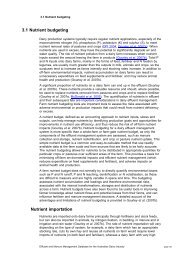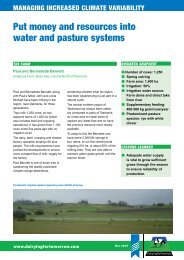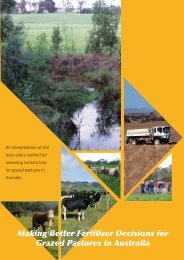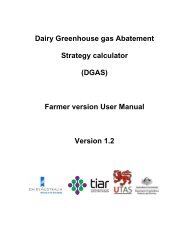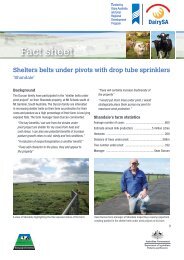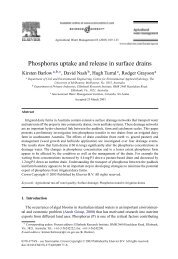Australian Dairy Industry In Focus 2009 - Dairying For Tomorrow
Australian Dairy Industry In Focus 2009 - Dairying For Tomorrow
Australian Dairy Industry In Focus 2009 - Dairying For Tomorrow
Create successful ePaper yourself
Turn your PDF publications into a flip-book with our unique Google optimized e-Paper software.
Whey products and casein<br />
Whey is a by-product of the cheese<br />
making process. Traditionally, this<br />
product was disposed of in liquid<br />
form. However, recognition of the<br />
value of whey’s components has seen<br />
the production and utilisation of whey<br />
powders and protein concentrates increase<br />
significantly in recent years.<br />
Food-grade whey powder is used in the<br />
manufacture of ice-cream, bakery products<br />
(cakes, biscuits), chocolate flavouring,<br />
infant formula, yogurt, beverages and<br />
processed meat. <strong>In</strong>dustrial uses include<br />
animal feed (for pigs, horses and<br />
poultry), calf milk replacer and even<br />
as a carrier for herbicides.<br />
Whey protein concentrates are used<br />
in snack foods, juices, confectionery,<br />
ice-cream, biscuits, processed meats,<br />
(milk) protein drinks, desserts,<br />
infant foods and dietetic products.<br />
Products such as cosmetics, skin<br />
creams, bath salts and detergents also<br />
contain protein concentrates.<br />
Approximately 20% of Australia’s<br />
whey production is used domestically<br />
in the manufacture of infant formula,<br />
biscuits and ice-cream. The remainder<br />
is exported. China, Singapore, the<br />
Philippines, Thailand and Malaysia are<br />
the largest export markets for <strong>Australian</strong><br />
whey powders in 2008/09.<br />
Casein and caseinates are ingredients<br />
in noodles, chocolate, sweets,<br />
mayonnaise, ice-cream and cheese<br />
manufacture. They are used as binding<br />
ingredients, emulsifiers and milk<br />
substitutes in processed foods.<br />
<strong>In</strong>dustrial uses of casein and caseinates<br />
include: plastics (buttons, knitting<br />
needles); the manufacture of synthetic<br />
fibres and chemicals (plants, glues,<br />
glazed paper, putty and cosmetics);<br />
as a reinforcing agent and stabiliser<br />
for rubber in automobile tyres;<br />
a nutritional supplement and binder<br />
in calf milk replacers; and a range<br />
of other technical applications.<br />
The majority of Australia’s production<br />
of casein and caseinates is for export<br />
markets. The US and Japan have been the<br />
largest export markets in recent years.<br />
Figure 23<br />
Production and exports of whey products (tonnes)<br />
Production<br />
120,000<br />
Exports<br />
110,000<br />
100,000<br />
90,000<br />
80,000<br />
Tonnes<br />
70,000<br />
60,000<br />
50,000<br />
40,000<br />
30,000<br />
20,000<br />
10,000<br />
0<br />
2000/01<br />
2001/02<br />
2002/03<br />
2003/04<br />
2004/05<br />
2005/06<br />
2006/07<br />
2007/08<br />
2008/09(p)<br />
32<br />
<strong>Australian</strong> <strong>Dairy</strong> <strong><strong>In</strong>dustry</strong> <strong>In</strong> <strong>Focus</strong> <strong>2009</strong><br />
Source: <strong>Dairy</strong> manufacturers and ABS



